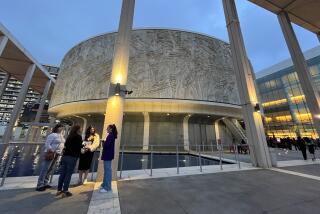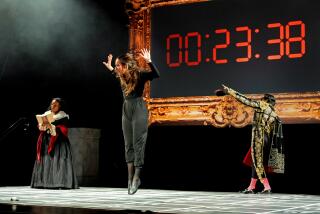Wagner’s ‘Ring’ has an ardent circle in L.A.
Typically, artistic ventures are judged two ways: by the critical community and in the court of public opinion. But in the case of Richard Wagner’s four-part “Der Ring des Nibelungen,” attention must be paid to a third constituency: enthusiasts of the cycle. These opera-goers -- “Wagnerites” if you want to be kind, “ ‘Ring’ nuts” if you’re less charitable -- are not professional evaluators, yet they are likely to have seen more “Ring” productions than all but the most assiduous music critics. Yet unlike critics, they are unabashed fans, rooting for Wagner’s music dramas no matter how outlandishly rendered.
“As long as I continue to have a pulse and go to operas, going to ‘The Ring’ is something I aim to do,” says Tim Toohey, an intellectual property lawyer from Pasadena. “It’s the most revitalizing experience I have in opera.”
Hence it was inevitable that when Los Angeles Opera finally mounted the first installment in its long-promised “Ring” cycle -- staged and designed by the avant-garde German director Achim Freyer -- tongues would wag and e-mails would rip. The flurry started even before Feb. 21, the formal opening of “Das Rheingold,” the nearly three-hour prelude that sets the scene for the far longer operas that represent the heart of “The Ring”: “Die Walküre,” “Siegfried” and “Götterdämmerung.”
Invited by the company to various rehearsals, members of this rabid interest group began forming the opinions they would later refine as they returned, often more than once, to see Freyer’s production in its finished form.
Now, with “Rheingold” concluded and “Walküre” set to open Saturday (“Siegfried” and “Götterdämmerung” are scheduled for next season), these enthusiasts are mulling over Freyer’s vision of gods, monsters and mortals vying for a cache of gold -- a vision colorful and provocative but also symbol-laden and sometimes obscure -- and either excitedly anticipating more or making their peace with aspects of the conception that leave them cold.
Perhaps the most intense discussions have occurred within the 26-year-old Wagner Society of Southern California, a 300-member association of enthusiasts led by Sherwin Sloan, a retired eye surgeon who has seen 87 “Ring” cycles since discovering Wagner in the mid-1970s. “I’m a real Wagner cuckoo,” he says.
Sloan says that reaction from his group to Freyer’s production has been mixed but generally positive. “I personally found it fascinating and imaginative, though it was also static at times,” he says. “But just to have it here is positive.”
That conviction is virtually holy writ for local Wagnerites, and not just those enrolled in Sloan’s society. By common consent, “Ring” cycles, with their enormous scope and ambition and equally large budgets (L.A. Opera says its price tag is $32 million), announce a company’s arrival on the world stage.
“We don’t have a season that allows for people to come here and see three operas in four days,” Sloan says. “ ‘The Ring’ will attract people and serve a public-relations function, increasing interest in Los Angeles. We’re already on the cultural map, but this will be more so.”
Sloan is referring to the company’s plan to mount all four “Ring” operas in the space of nine days in June 2010. Three such cycles are scheduled.
For Wagnerites, seeing the entire “Ring” within roughly a week is a defining element of the experience. It is how Wagner himself intended for the works to be appreciated. He went as far as founding a summer music festival in Bayreuth, Germany, for the purpose.
“It’s very different seeing it all together as opposed to in pieces,” insists Toohey. “The experience allows one to draw connections, and the whole becomes greater than the sum of its parts. Also, musically it has a much bigger impact.”
Repeat buyers
Nowadays, thanks to jet travel, attending such events throughout the word is viable -- at least for those with funds and time to spare.
Eleanor Gnup, a retired high school librarian, and her husband, Eddy, began studying “The Ring” in 1980. They’ve now seen the cycle 22 times -- 13 at Bayreuth. “Before our first ‘Ring,’ we had never seen a Wagner opera, and I wondered if I’d really like it,” the Fullerton resident says. “But once we got into it, there’s no question we’re addicts. My daughter asks, ‘Mom, how many times do you want to see this?’ And I say, ‘It’s always a different experience, and the music is so great.’ ”
Enthusiasts such as the Gnups are arguably the most important consumers of Freyer’s new “Ring” -- repeat buyers, if you will. So it is good that they are mainly supportive, implicitly backing Plácido Domingo, L.A. Opera’s general director and this project’s driving force. (Domingo will also sing the role of Siegmund in “Die Walküre.”)
But not all local Wagnerites have been charmed. Eighty-year-old Herbert Berk of Los Angeles, whose interest in “The Ring” goes back to his boarding-school days, found “Rheingold” “confused and confusing.”
“Most people tell me they love this production,” Berk says. “I think Freyer is typical of these modern German Expressionists who don’t have much respect for the original intent of the composer. Can you imagine what Wagner would think of the airplane in ‘Rheingold’? I’ve been to 15 ‘Rings.’ The Met’s is the best. They do it the way Wagner intended. I got none of that feel with Freyer.”
Berk plans to go to a rehearsal of “Walküre” but has not committed to a regular performance. “If I don’t like ‘Walküre’ any more than I liked this ‘Rheingold,’ ” he says, “I don’t expect to buy a ticket.”
Others can’t wait for the next installment and the ones beyond that.
“I found it to be the most provocative, imaginative and thought-stimulating of any ‘Rheingold’ I have ever seen,” says Manny Gutierrez of Studio City. “Salvador Dalí, Giorgio de Chirico, André Breton and all of that ilk must be rollicking in the artistic heavens. It is an artistic delight.”
Nina Haro, a restaurateur in Venice, echoes that view. “I’m absolutely looking forward to ‘Die Walküre,’ ” she says. “I’ll be going to that a couple times, and I already have my tickets to the complete cycle.”
A Bayreuth veteran like everyone interviewed for this piece, Haro says she already expects Freyer’s production to be her favorite, surpassing the ultra-traditional Metropolitan Opera approach favored by Berk. “You have to use imagination, and I think being prepared beforehand is useful,” she says. “I took my daughter to ‘Rheingold.’ She’s an artist, so she appreciated it on that level, but I had to do some explaining.”
‘Walküre’ buzz
Thus far, Freyer’s production hasn’t received much national or international notice. But the company expects greater attention for the “Walküre.” What discussion has penetrated the blogosphere has been positive, after a fashion.
“It’s a step in the right direction,” says the popular blogger Opera Chic, an American living in Milan, Italy, who prefers that her identity not be revealed. “Personally, I’m not crazy for Freyer’s trademark puppet thing, but puppets and Japanese Noh theater references are better than a sea of boring gray trench coats” -- a European opera house cliché.
Some Wagnerites seem worried that what worked in the episodic “Rheingold” won’t hold up in the more static “Walküre,” while others wonder if the opposite might not be true.
Marvellee Cariaga, a former opera singer who once specialized in Wagner and now teaches at Cal State Long Beach, was unmoved by Freyer’s vision. Her primary concern now is the singers, whom even fans of the production acknowledge may be hampered by Freyer’s elaborate costumes.
“They were at the greatest disadvantage of any production I’ve ever seen, given the scrim, the static positioning and the way they were placed at the back of the stage,” Cariaga says of “Rheingold.”
She also wasn’t thrilled by James Conlon’s conducting, which she found too fast and called “stylized,” saying it lacked tension.
Others have complained about the cover Conlon placed over the orchestra pit in an attempt to dampen sound and pay homage to Bayreuth, whose Festspielhaus obscures the orchestra to achieve a singular sonic picture and give singers every advantage.
Still, for the majority of Southern California’s Wagnerites, Freyer’s production represents a great leap forward for local operatic fortunes, bringing with it the promise of a bona fide adventure. So far, Freyer’s “Ring” may be many things, but boring isn’t among them.
“Wagner said, ‘Always do new things. Just don’t have them stand there with their spears,’ ” Sloan observes. “New productions create new thoughts.”
More to Read
The biggest entertainment stories
Get our big stories about Hollywood, film, television, music, arts, culture and more right in your inbox as soon as they publish.
You may occasionally receive promotional content from the Los Angeles Times.






